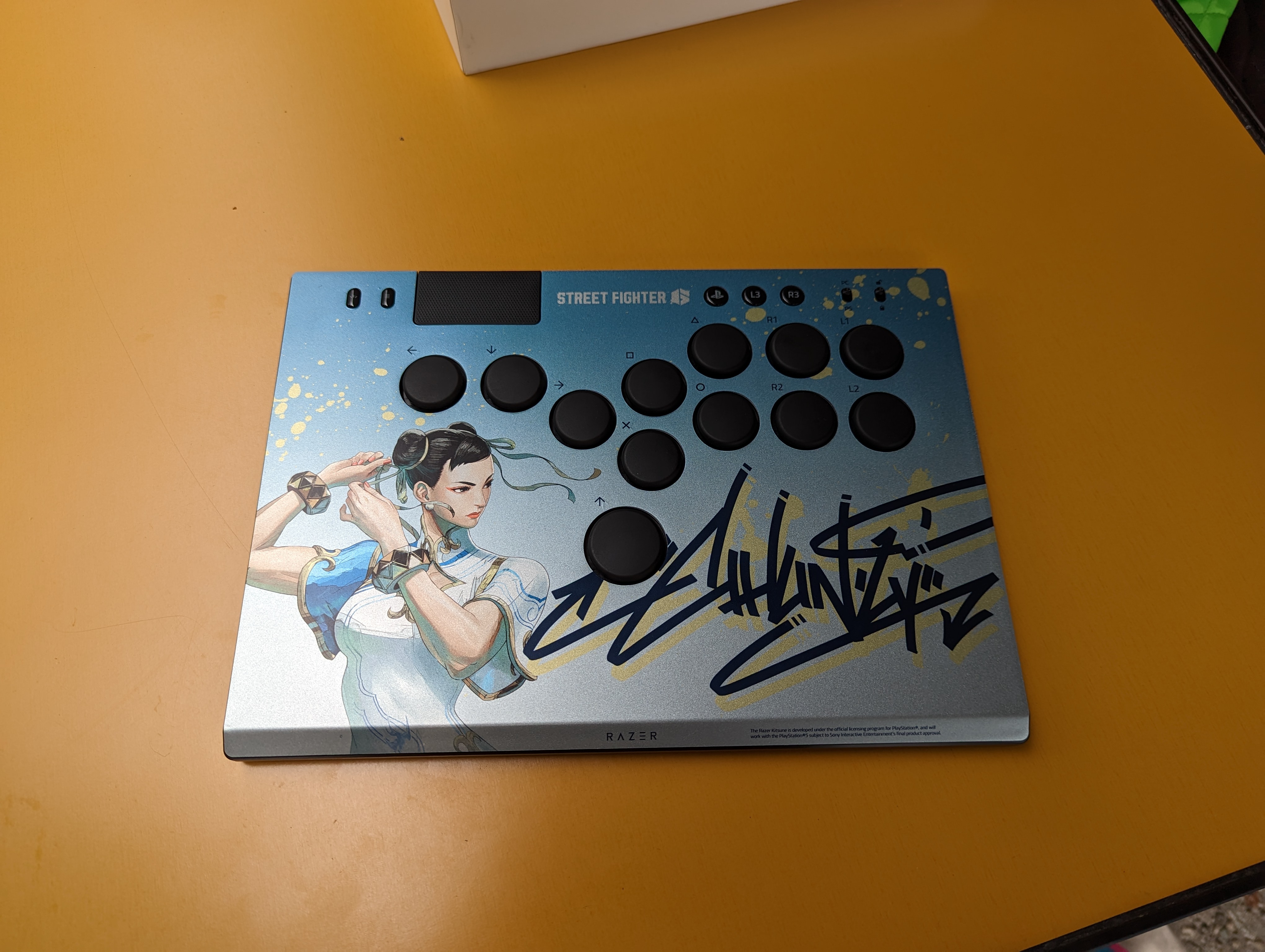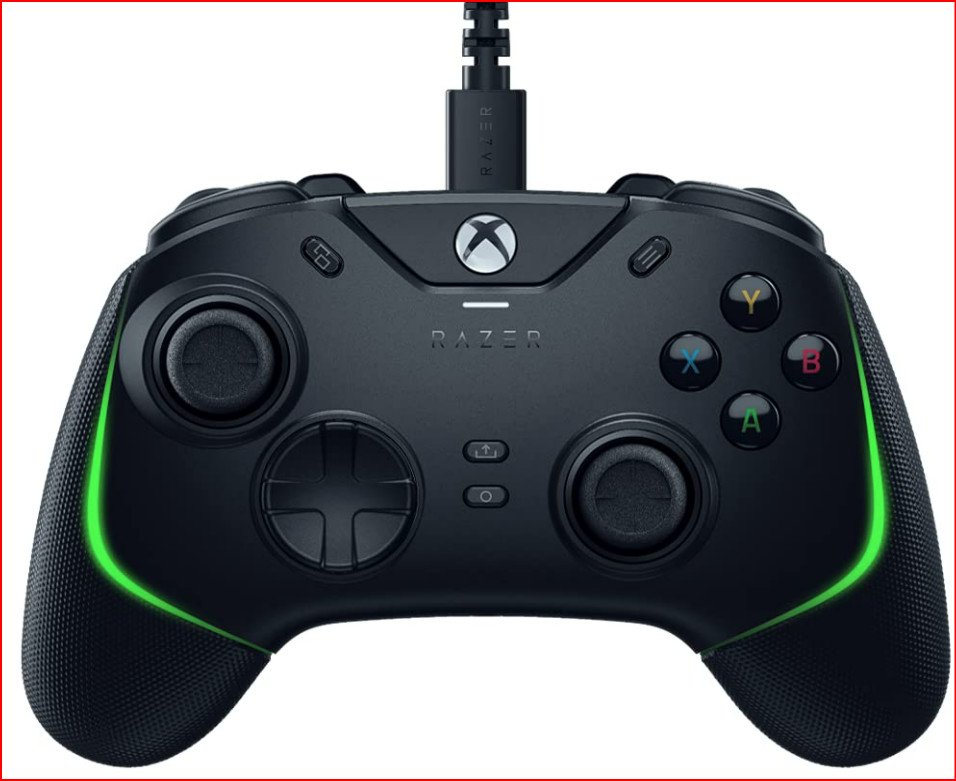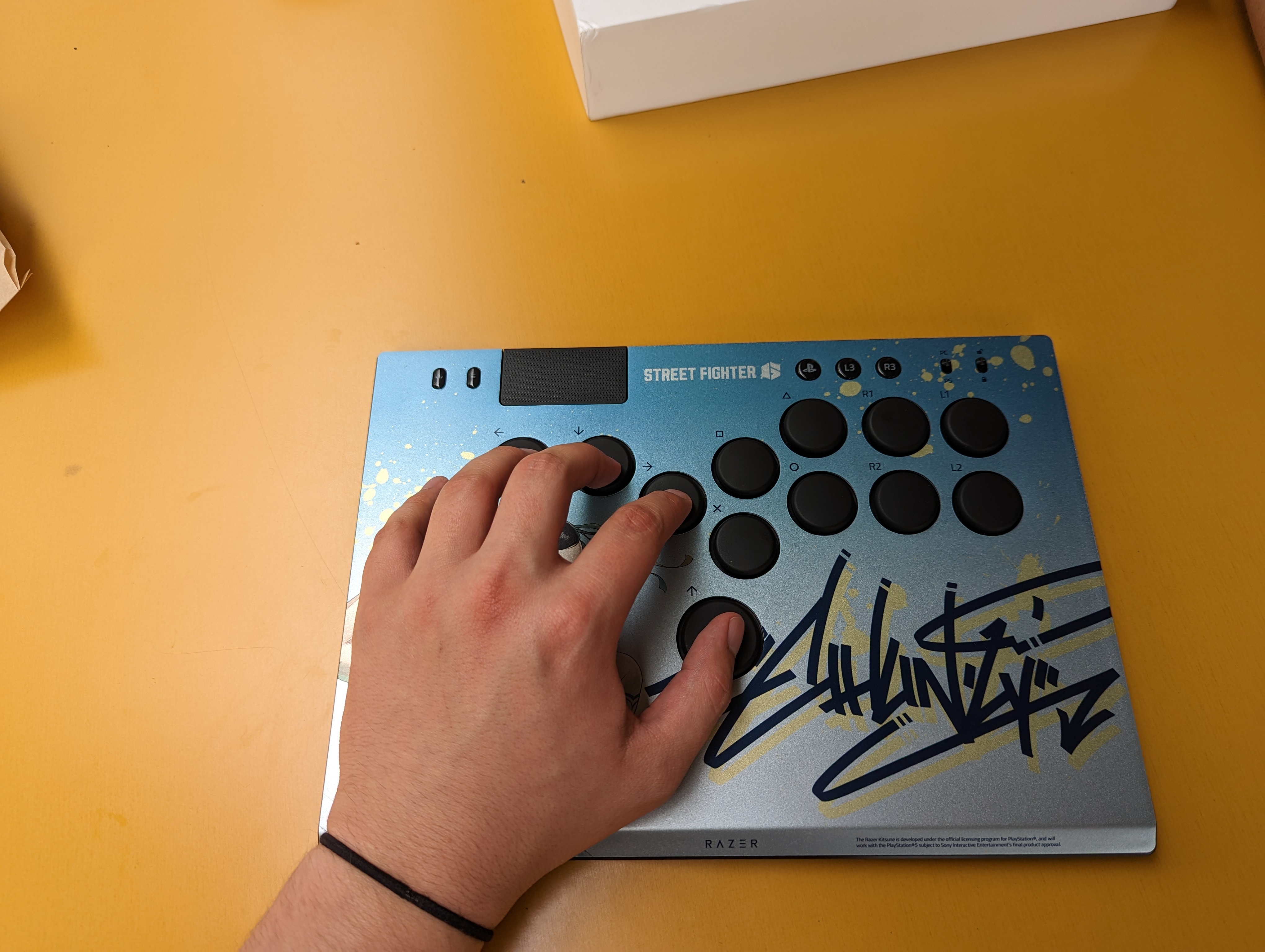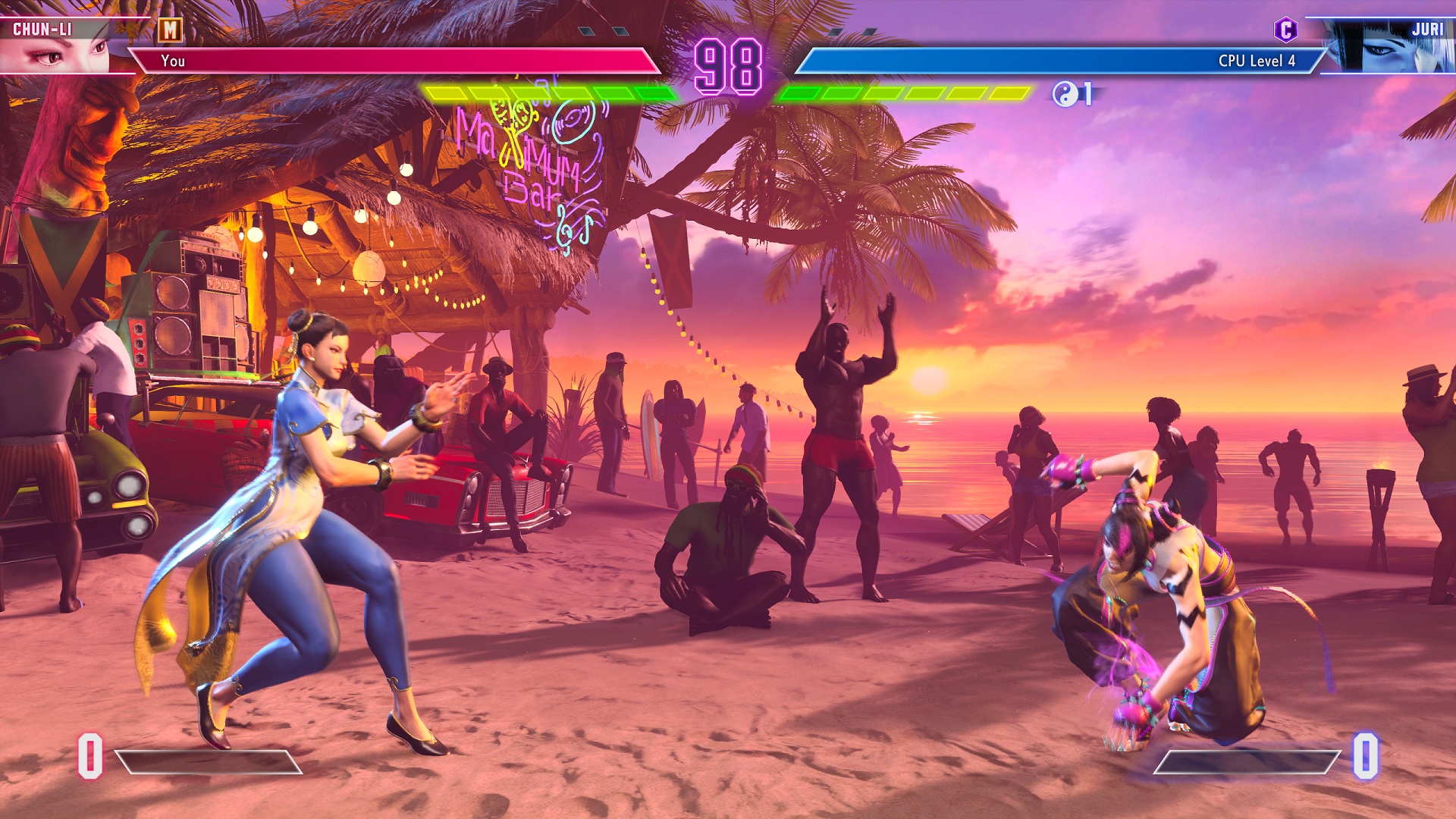Going hands-on with the Razer Kitsune and more at Summer Games Fest 2023
Checking out some of Razer's cutting-edge devices

Razer may not have had a fancy CG trailer revealing its latest pieces of hardware at Summer Games Fest's live event, but it had a big presence at Play Days, the SGF-affiliated demo event for press and media. The company provided a lot of the hardware used on the show floor and debuted its first fight stick in years: the Kitsune.
Razer Kitsune First Impressions
At the beginning of June, Razer unveiled the Kitsune. A leverless fight stick, the Kitsune is designed to go toe-to-toe with other fighting game-centric peripherals, like the Hit Box, without inviting the same controversies. I had the opportunity to go hands-on with one at the Summer Game Fest’s Play Days demo event. While what I saw may not reflect the final version of the product, this version of the controller was playable at the Mortal Kombat 1 demo booth. While Razer hasn’t announced a firm release date yet, a company spokesperson confirmed that they plan to release the stick later this year.
A fight stick is a type of controller designed to emulate the feel of a traditional arcade cabinet’s button layout. Featuring a classic joystick, eight buttons on the front representing the face buttons, bumpers, and triggers found on a controller, and a few more buttons to fill in for any UI buttons you might find on a traditional controller. They’re the closest you can get to the arcade feel at home without cramming an arcade cabinet in your living room. The fighting game community overwhelmingly prefers them for their precision and layout. Think of it as the same reason people who play competitive shooters favor a keyboard and mouse layout over a controller — many games fighting games were originally designed to be played with a joystick in an arcade cabinet, not with a standard pad.
Recently, however, a new type of fight stick has been making waves in the FGC: the leverless fight stick or box. The term “stick” is a bit of a misnomer, as there’s no joystick to speak of, with four buttons representing the cardinal directions replacing the eponymous feature. Over the last four years, boxes have become increasingly popular at all levels of play because of how precisely they can read directional inputs. Where a stick leaves room for even the most experienced player to overshoot or turn in an incomplete motion on a mis-input, a leverless one shaves the margin for error down to a near-minuscule degree.
The Feel
Right off the bat, this is a major step up from the Hit Box, the most well-known leverless fight stick and the only one of its type I’ve used before. Companies like PDP and SnackBox also make leverless sticks.
Razer knows how to make a good button, and with years of experience manufacturing keyboards, it’s no surprise that the Kitsune almost feels like a cross between a Hit Box and a nice keyboard. Its large, round buttons have a nice texture on them. Pressing them doesn’t feel as clicky as a standard stick, but they still feel solid.
Where the Kitsune sacrifices that iconic click, it gains something that very few of its competitors can boast: size. Where most fight sticks — leverless or otherwise — are usually around seven centimeters thick, the Kitsune is around one centimeter thick. This may not sound like a huge difference, but it makes a difference in ergonomics. The Kitsune’s almost nonexistent profile feels amazing. This is easily my favorite feature as someone with some serious wrist issues.
All the latest news, reviews, and guides for Windows and Xbox diehards.
That slim profile also makes the controller highly portable; it weighs very little and would easily fit into the laptop sleeve of just about any bag. I prefer to play fighting games locally, so knowing I wouldn’t need to lug around a much bigger and heavier device is immensely reassuring.
The controversy
This new controller type has been a lightning rod for controversy among fighting game players. Hit Box allowed players to pull off inputs that aren’t otherwise possible with standard controllers or arcade sticks.
You can only input one direction at a time on standard joysticks, d-pads, and analog sticks. Some — like the standard analog sticks you should expect to find in a standard Xbox controller, for example — will read a few more directions than on something like a D-Pad. However, they’re still bound to similar constraints regardless of how many directions they can read.
Leverless sticks, on the other hand, make it so that you’re able to input opposite directions at the same time. This is particularly potent in fighting games because most games in the genre involve precise directional movements not only for moving and attacking but also for blocking. In some instances, players have been able to use a leverless fight stick to do things like block in two directions at once or bypass certain time-based constraints for executing moves. These controllers have become so infamous that some community members have started calling them “cheat boxes.” In response, tournament organizers and circuits, like the Capcom Pro Tour, have issued various forms of regulation for leverless sticks over the years, curbing some of the controllers’ most extreme exploits.
Razer’s spokesperson was adamant that the controversies surrounding other leverless sticks were a driving factor in the production and design of the Kitsune, telling me that the Kitsune will ship with the necessary firmware out-of-the-box. Of course, fighting games are always changing; exploits and techniques are still being unearthed for games over a decade old, so Razer will probably need to push new firmware updates as new discoveries are made.
The catch?
It may be smaller and more portable than most other controllers like it, and while still checking every box that a leverless fight stick needs to, it’s also very expensive. Sitting at a retail price of USD 299.99, it’s not the cheapest option. On top of that, the SnackBox and Hit Box can be used on multiple console platforms, whereas the Kitsune is officially licensed by PlayStation and only usable on PlayStation and PC.
Additionally, some purists might not like the feel of the buttons compared to a traditional stick. They don’t feel the same as an arcade machine’s buttons. Kitsune’s shorter profile means it doesn't use the same button switches as traditional sticks do, opting to use Razer's keyboard tech instead. I don’t mind the change, but anyone looking for that extra click may be disappointed.
The potential
Razer’s Kitsune could be a really great tool for fighting game players. This may be Razer’s first stick in a while, but the company’s years of hardware manufacturing shine through in its design and feel. Its price compared to other similar products, like the SnackBox, is a clear issue, and purists may prefer the beefier sticks for their more classic feel, but it’s still a good-feeling leverless stick that I’m excited to get my hands on once it launches later this year.
Checking out other Razer products
While Kitsune was the only new controller Razer showed off at Play Days, the hardware manufacturer provided hardware, including controllers, keyboards, mice, and headsets for nearly every demo station on the campus, including Mortal Kombat 1, Immortals of Aveum, and a smattering of great indie games.
When I think about 3rd-party controllers, I think of growing up in the 2000s—the age of MadCatz and mountains of Wii peripherals—third-party controllers for consoles were often a gamble at best. Even as someone who’s reasonably cautious with his tech, I’ve gone through a wealth of gaming hardware through sheer sustained use because many budget-friendly controllers just aren’t built to last. When it comes to something with as many moving parts as a controller, price points can often indicate whether or not something is designed for sustained, long-term use. First-party controllers, especially Xbox, always last me the longest.
That’s the main reason I tend to prefer the current generation’s lineup of first-party controllers. Usually, I only wander off the beaten path to find a controller to fill a specific niche, like 8BitDo’s SN30 series, when I want to get my hands on a nice, classic D-Pad. Otherwise, I make a point to save the extra cash to ensure a more consistent, well-supported experience.
The same goes for other tech and accessories; unless it’s a highly-specific use case that I fall into, I generally talk myself out of buying accessories for my PC or consoles beyond the bare basics because they can run you a pretty penny and take up valuable desk space and USB ports. In fact, aside from my Logitech ERGO K860, I shoot for budget above all else. Most of the time, I don’t fall into the category of high-end use case tech products.
I can appreciate side buttons on mice or paddles on the back of a controller. Still, aside from the occasional Smash tournament, I don’t play games at a competitive enough level to justify bells and whistles beyond controllers and keyboards that feel good and have a quick response time. While I can tell the difference, I don't usually mind it.
However, Razer's presence at Play Days made a strong case for premium gaming hardware. Where options like Xbox’s elite controllers or Scuf’s eSports-friendly offerings are too pricey for what I look for in a controller, I was pleasantly surprised that Razer’s Wolverine V2 Chroma hit the right feel without the same high price point found in other premium options. After all, it's one of the best Xbox controllers.

Bottom line: The Razer Wolverine V2 Chroma is undeniable in its quality, with great construction, materials, and ergonomics. For what it lacks in wirelessness, it makes up for it with features. That sensitivity clutch almost feels like cheating for competitive FPS, and back paddles ensure you never have to take your thumbs away from movement.

Charlie's a former freelancer for Windows Central based in Chicago, IL.




